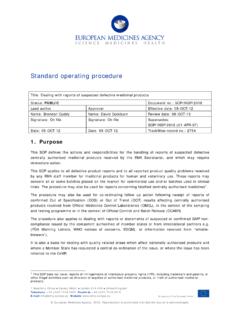Transcription of Guideline on assessment and control of DNA reactive ...
1 6 December 2018. EMA/CVMP/SWP/377245/2016. Committee for Medicinal Products for Veterinary Use (CVMP). Guideline on assessment and control of DNA reactive (mutagenic) impurities in veterinary medicinal products Agreed by Safety Working Party (SWP-V) November 2016. Agreed by Efficacy Working Party (EWP-V) December 2016. Agreed by Quality Working Party (QWP) February 2017. Adoption by CVMP for release for consultation 16 February 2017. Start of public consultation 24 February 2017. End of consultation (deadline for comments) 31 August 2017. Agreed by EWP-V 30 May 2018. Agreed by QWP 28 September 2018.
2 Agreed by SWP-V 23 October 2018. Adoption by CVMP 6 December 2018. Date for coming into effect 1 July 2020. Keywords impurity, mutagenic, carcinogenic, DNA - reactive 30 Churchill Place Canary Wharf London E14 5EU United Kingdom Telephone +44 (0)20 3660 6000 Facsimile +44 (0)20 3660 5555. Send a question via our website An agency of the European Union European Medicines Agency, 2018. Reproduction is authorised provided the source is acknowledged. Guideline on assessment and control of DNA reactive (mutagenic) impurities in veterinary medicinal products Table of contents 1.
3 Introduction .. 4. 2. Scope of Guideline .. 4. 3. Legal basis .. 5. 4. General 5. 5. Considerations for authorised products .. 6. Post approval changes to the drug substance chemistry, manufacturing, and 6. Post approval changes to the drug product chemistry, manufacturing, and controls .. 7. Changes to the clinical use of authorised products .. 7. Other considerations for authorised products .. 7. 6. Drug substance and veterinary medicinal product impurity assessment . 8. Synthetic impurities .. 8. Degradation 8. 7. Hazard assessment elements .. 9. 8. Risk characterisation.
4 10. Threshold of Toxicological Concern (TTC) based acceptable intakes .. 10. Acceptable intakes based on compound-specific risk assessments .. 11. Mutagenic impurities with positive carcinogenicity data (Class 1) .. 11. Mutagenic impurities with evidence for a practical threshold .. 11. Acceptable intakes in relation to less-than-lifetime (LTL) exposure for companion animals .. 11. Acceptable intakes for multiple mutagenic impurities .. 12. Exceptions and flexibility in 12. 9. control .. 12. control of process related impurities .. 13. Considerations for control approaches.
5 14. Considerations for periodic testing .. 15. control of degradation products .. 15. Lifecycle management .. 15. Guideline on assessment and control of DNA reactive (mutagenic) impurities in veterinary medicinal products EMA/CVMP/SWP/377245/2016 Page 2/26. 10. Documentation .. 16. Notes .. 17. Definitions .. 18. References .. 20. Appendix 1 .. 21. Conversion of the TTC-based acceptable intake to a specific concentration limit for a veterinary drug substance (example) .. 21. Appendix 2 .. 22. Decision tree of impurity classification .. 22. Appendix 3 .. 23. Scope scenarios for application of the Guideline .
6 23. Appendix 4 .. 25. Case examples to illustrate potential control approaches .. 25. Guideline on assessment and control of DNA reactive (mutagenic) impurities in veterinary medicinal products EMA/CVMP/SWP/377245/2016 Page 3/26. 1. Introduction The synthesis of drug substances involves the use of reactive chemicals, reagents, solvents, catalysts, and other processing aids. As a result of chemical synthesis or subsequent degradation, impurities reside in all drug substances and associated veterinary medicinal products (VMPs). While VICH GL10: Impurities in New Veterinary Drug Substances (Ref.)
7 1) and VICH GL11 (Ref. 2): Impurities in New Veterinary Medicinal Products provide guidance for qualification and control for the majority of the impurities, limited guidance is provided for those impurities that are DNA reactive . The purpose of this Guideline is to provide a practical framework that is applicable to the identification, categorisation, qualification, and control of these mutagenic impurities, to limit potential carcinogenic risk associated with the exposure to potentially mutagenic impurities. This Guideline is intended to complement VICH. GL10 and VICH GL11.
8 This Guideline considers both safety and quality risk management in establishing levels of mutagenic impurities that are expected to pose negligible carcinogenic risk. It outlines recommendations for assessment and control of mutagenic impurities that remain or are reasonably expected to remain in the final drug substance or VMP. The approach of this Guideline is based on that of ICH Guideline M7 (Ref. 3) on assessment and control of DNA reactive (mutagenic) impurities in pharmaceuticals to limit potential carcinogenic risk which was used as a template, with amendments introduced in order to cover the issues specific to VMPs.
9 2. Scope of Guideline This document is intended to provide guidance for new veterinary drug substances and new VMPs, including cases where drug substances can be used in both human and veterinary drug products. Post-approval submissions of authorised products ( , variations), or applications for new marketing authorisations for VMPs that include drug substances that have previously been present in authorised VMPs are also in the scope of this Guideline , but only in cases where: Changes to the synthesis of the drug substance result in new impurities or increased acceptance criteria for specified impurities.
10 Changes in the formulation, composition or manufacturing process result in new degradation products or increased acceptance criteria for specified degradation products;. Changes in indication, dosing regimen or target species are made which significantly affect the acceptable exposure level. assessment of the mutagenic potential of impurities as described in this Guideline is not intended for the following types of drug substances and drug products: biologicals/biotechnologicals, peptides, oligonucleotides, radiopharmaceuticals, fermentation products, herbal products, and crude products of animal or plant origin.










